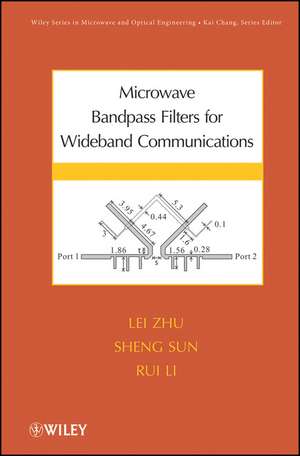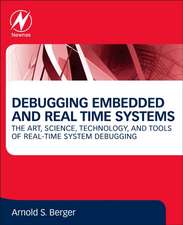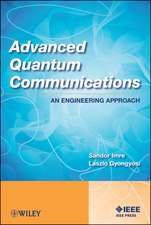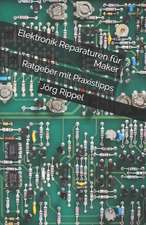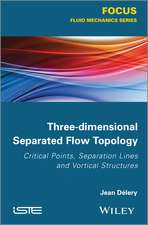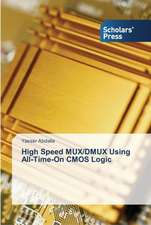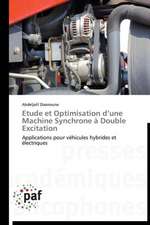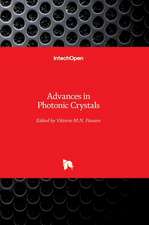Microwave Bandpass Filters for Wideband Communications: Wiley Series in Microwave and Optical Engineering
Autor L Zhuen Limba Engleză Hardback – 8 mar 2012
Din seria Wiley Series in Microwave and Optical Engineering
- 24%
 Preț: 839.62 lei
Preț: 839.62 lei - 9%
 Preț: 724.40 lei
Preț: 724.40 lei - 9%
 Preț: 1484.37 lei
Preț: 1484.37 lei - 9%
 Preț: 1269.67 lei
Preț: 1269.67 lei - 9%
 Preț: 748.72 lei
Preț: 748.72 lei - 9%
 Preț: 1233.54 lei
Preț: 1233.54 lei - 9%
 Preț: 1051.24 lei
Preț: 1051.24 lei - 9%
 Preț: 773.26 lei
Preț: 773.26 lei - 9%
 Preț: 1448.43 lei
Preț: 1448.43 lei - 9%
 Preț: 844.67 lei
Preț: 844.67 lei - 9%
 Preț: 962.34 lei
Preț: 962.34 lei - 9%
 Preț: 1294.72 lei
Preț: 1294.72 lei - 9%
 Preț: 1266.53 lei
Preț: 1266.53 lei - 9%
 Preț: 1463.96 lei
Preț: 1463.96 lei - 9%
 Preț: 808.71 lei
Preț: 808.71 lei - 9%
 Preț: 1386.11 lei
Preț: 1386.11 lei - 9%
 Preț: 1048.49 lei
Preț: 1048.49 lei - 9%
 Preț: 885.35 lei
Preț: 885.35 lei - 9%
 Preț: 1023.70 lei
Preț: 1023.70 lei - 9%
 Preț: 1156.52 lei
Preț: 1156.52 lei - 9%
 Preț: 1203.93 lei
Preț: 1203.93 lei - 9%
 Preț: 1108.07 lei
Preț: 1108.07 lei - 9%
 Preț: 1065.12 lei
Preț: 1065.12 lei - 9%
 Preț: 1228.62 lei
Preț: 1228.62 lei - 9%
 Preț: 1084.30 lei
Preț: 1084.30 lei - 9%
 Preț: 1357.61 lei
Preț: 1357.61 lei - 9%
 Preț: 1579.71 lei
Preț: 1579.71 lei - 9%
 Preț: 1418.62 lei
Preț: 1418.62 lei - 9%
 Preț: 934.98 lei
Preț: 934.98 lei - 9%
 Preț: 1096.97 lei
Preț: 1096.97 lei - 9%
 Preț: 1101.80 lei
Preț: 1101.80 lei - 9%
 Preț: 1213.91 lei
Preț: 1213.91 lei - 9%
 Preț: 1339.55 lei
Preț: 1339.55 lei - 9%
 Preț: 866.27 lei
Preț: 866.27 lei - 9%
 Preț: 1797.25 lei
Preț: 1797.25 lei - 9%
 Preț: 1160.31 lei
Preț: 1160.31 lei - 9%
 Preț: 801.17 lei
Preț: 801.17 lei - 9%
 Preț: 1276.33 lei
Preț: 1276.33 lei - 9%
 Preț: 1423.37 lei
Preț: 1423.37 lei - 9%
 Preț: 1095.58 lei
Preț: 1095.58 lei - 9%
 Preț: 970.80 lei
Preț: 970.80 lei - 9%
 Preț: 1174.76 lei
Preț: 1174.76 lei - 9%
 Preț: 1344.87 lei
Preț: 1344.87 lei - 9%
 Preț: 1334.03 lei
Preț: 1334.03 lei - 9%
 Preț: 1006.11 lei
Preț: 1006.11 lei - 9%
 Preț: 1068.04 lei
Preț: 1068.04 lei - 9%
 Preț: 1073.60 lei
Preț: 1073.60 lei - 9%
 Preț: 1191.14 lei
Preț: 1191.14 lei - 9%
 Preț: 1078.27 lei
Preț: 1078.27 lei - 9%
 Preț: 1364.55 lei
Preț: 1364.55 lei
Preț: 792.82 lei
Preț vechi: 871.24 lei
-9% Nou
Puncte Express: 1189
Preț estimativ în valută:
151.72€ • 164.75$ • 127.45£
151.72€ • 164.75$ • 127.45£
Carte tipărită la comandă
Livrare economică 23 aprilie-07 mai
Preluare comenzi: 021 569.72.76
Specificații
ISBN-13: 9780470876619
ISBN-10: 0470876611
Pagini: 240
Dimensiuni: 156 x 240 x 14 mm
Greutate: 0.52 kg
Editura: Wiley
Seria Wiley Series in Microwave and Optical Engineering
Locul publicării:Hoboken, United States
ISBN-10: 0470876611
Pagini: 240
Dimensiuni: 156 x 240 x 14 mm
Greutate: 0.52 kg
Editura: Wiley
Seria Wiley Series in Microwave and Optical Engineering
Locul publicării:Hoboken, United States
Public țintă
Academic researchers, design engineers, graduate studentsCuprins
Notă biografică
LEI ZHU, PhD, is Associate Professor at the School of Electrical and Electronic Engineering, Nanyang Technological University, Singapore. Dr. Zhu was the first to introduce an MMR-based filter in 2000, which has since spurred the successful development of a new class of wideband filters with fractional bandwidths larger than 60 percent. SHENG SUN, PhD, is Research Assistant Professor in the Department of Electrical and Electronic Engineering at The University of Hong Kong. RUI LI, PhD, is a Research Fellow in the Interconnection and Advanced Packaging Program at Singapore's Institute of Microelectronics. She was the recipient of both the NTU Research and the Ministry of Education Scholarships in Singapore.
Descriere
This book will appeal to scientists and engineers who are concerned with the design of microwave wideband devices and systems. For advanced (ultra)-wideband wireless systems, the necessity and design methodology of wideband filters will be discussed with reference to the inherent limitation in fractional bandwidth of classical bandpass filters.
